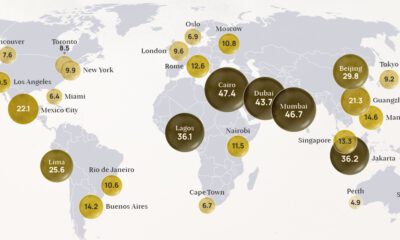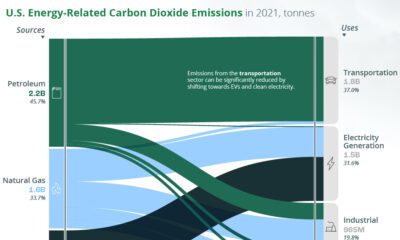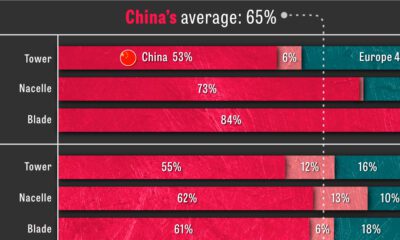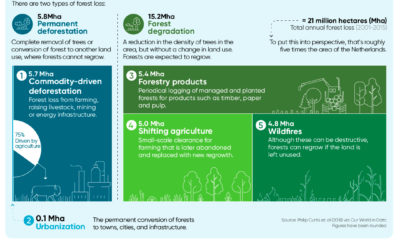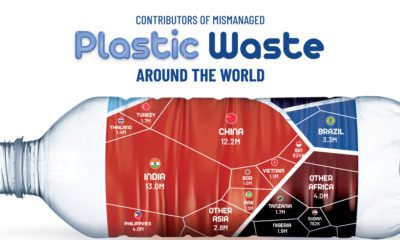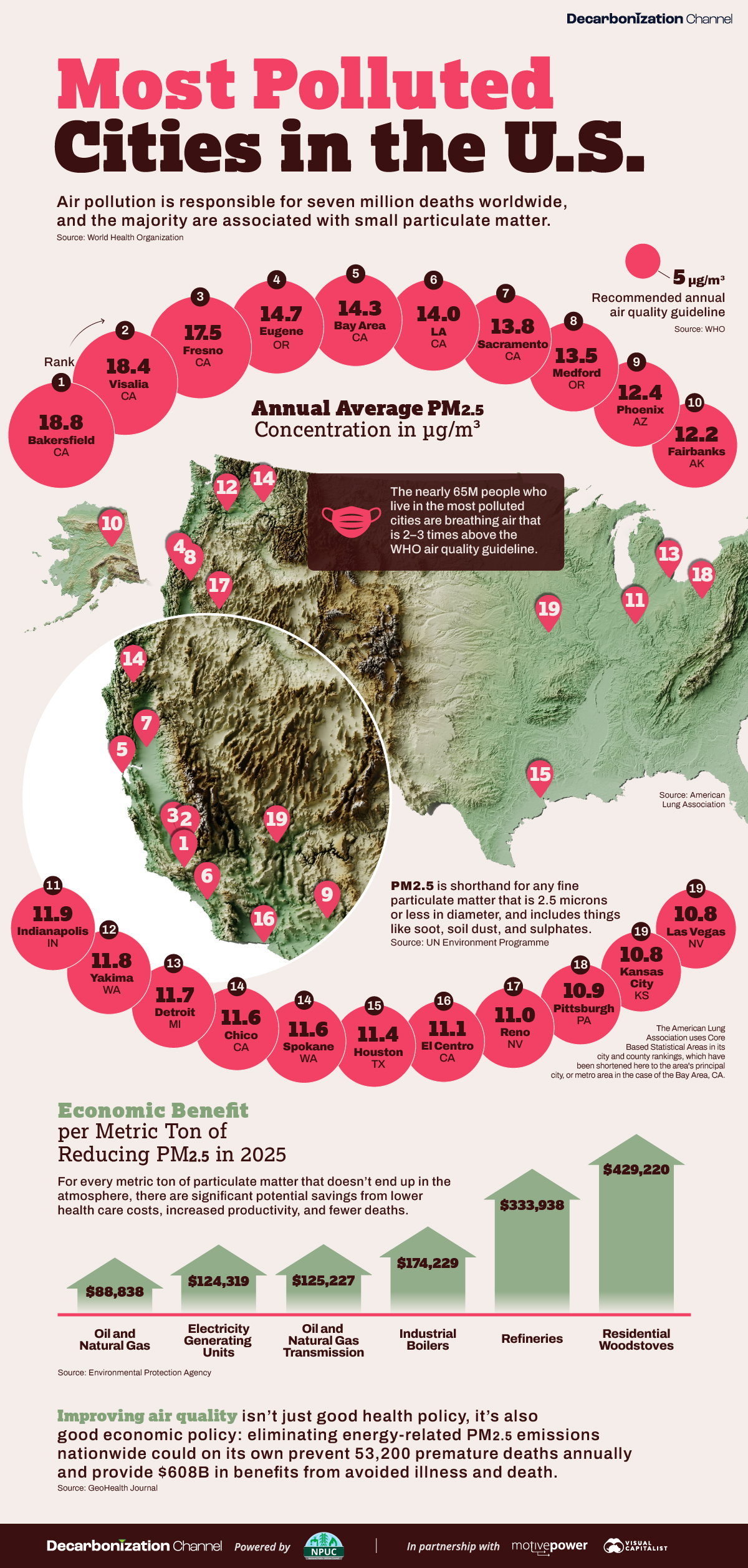Green
Visualizing the Scale of Plastic Bottle Waste Against Major Landmarks
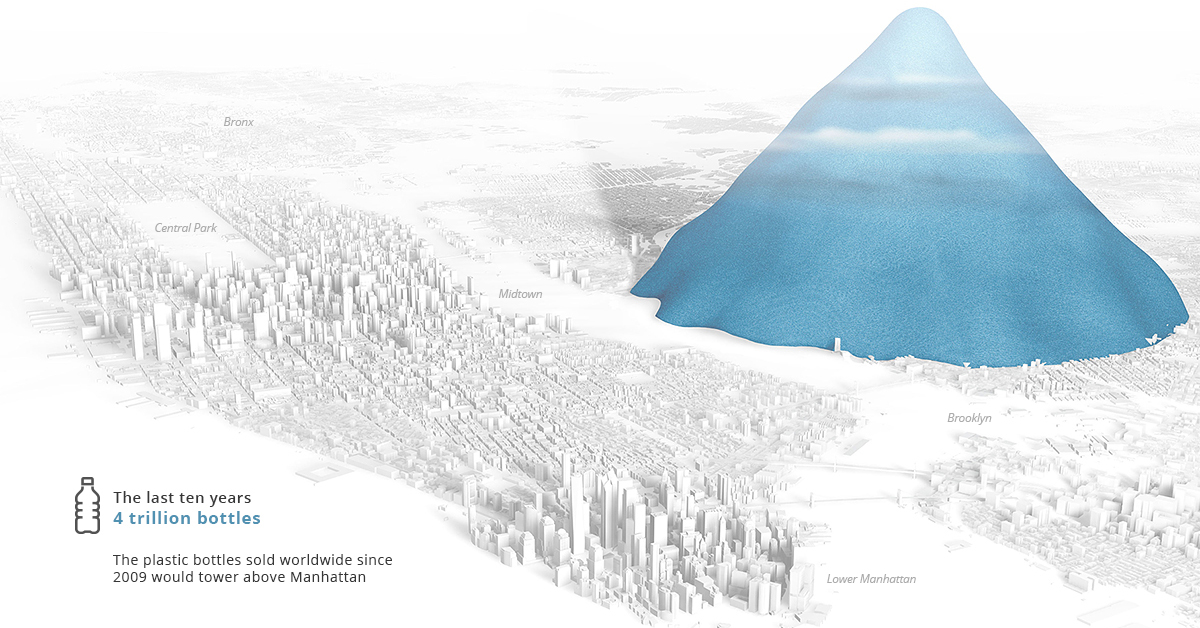
View the original interactive visualization at Reuters Graphics.
Visualizing the Scale of Plastic Bottle Waste
By the time you’re finished reading this sentence, tens of thousands of plastic bottles will have been sold around the world.
The ubiquitous plastic bottle has proven to be a versatile and cost-effective vessel for everything from water to household cleaning products. Despite this undeniable utility, it’s becoming harder to ignore the sheer volume of waste created by the world’s 7.5 billion people.
Today’s data visualization from Simon Scarr and Marco Hernandez at Reuters Graphics puts into perspective the immense scale of plastic bottle waste by comparing it to recognizable global landmarks, and even the entirety of Manhattan.
Plastic Wasted in One Hour

Original image from REUTERS/Simon Scarr, Marco Hernandez.
Every hour, close to 55 million bottles are discarded worldwide. When accumulated, the pile would be higher than the Brazilian Art Deco statue, Christ the Redeemer.
Towering over Rio de Janeiro at 125 feet (38 meters) and with arms outstretched to 98ft (30m), the statue still pales in comparison next to the combined plastic bottle waste over this time period.
Plastic Bottle Waste: Daily and Monthly
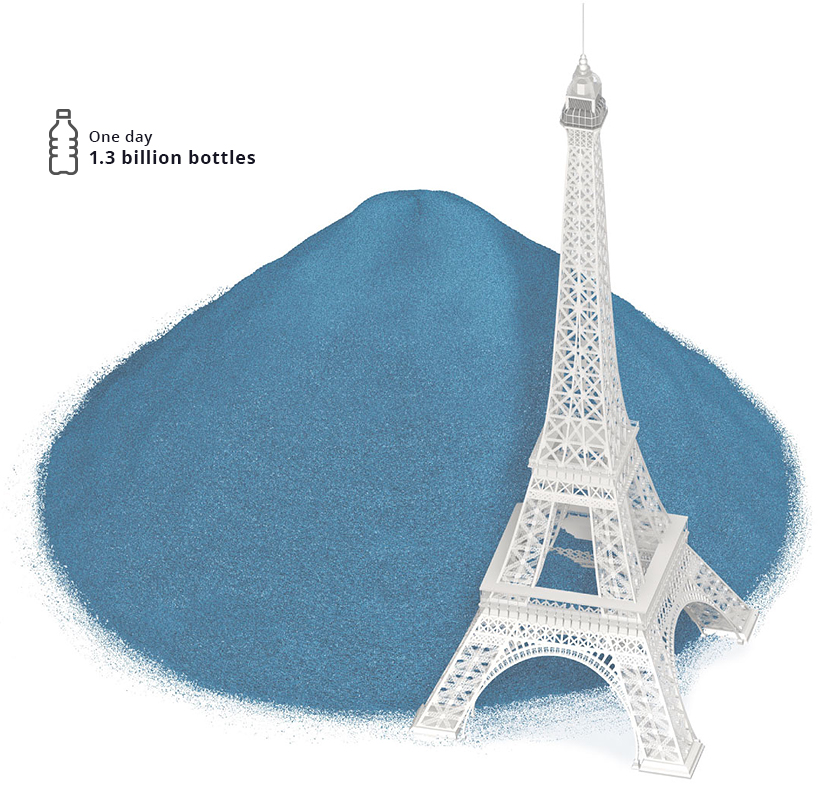
Original image from REUTERS/Simon Scarr, Marco Hernandez.
In the span of a day, over 1.3 billion bottles are discarded. If you were to take the elevator up the Eiffel Tower (which has a total height of 1,063ft or 324m), you’d reach the tip of this pile about halfway up.
Fast forward this by a month, however, and it’s a different story. The Eiffel Tower seems like a figurine next to a heap of approximately 40 billion tossed plastic bottles.
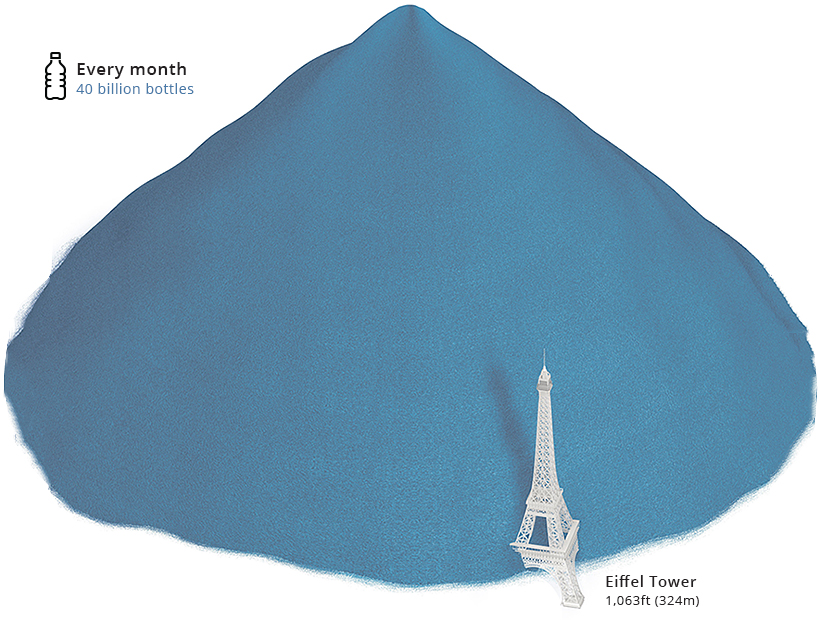
Original image from REUTERS/Simon Scarr, Marco Hernandez.
Scaling this up, data from Euromonitor International reveals that over 481 billion plastic bottles are now wasted annually.
Accumulated, this would dwarf even Dubai’s famous Burj Khalifa, the world’s tallest structure at an impressive 2,722ft (830m).
A Decade of Plastic
According to Reuters, nearly 4 trillion bottles were sold in the past ten years, each contributing to a 7,874ft high pile of plastic (2.4km).
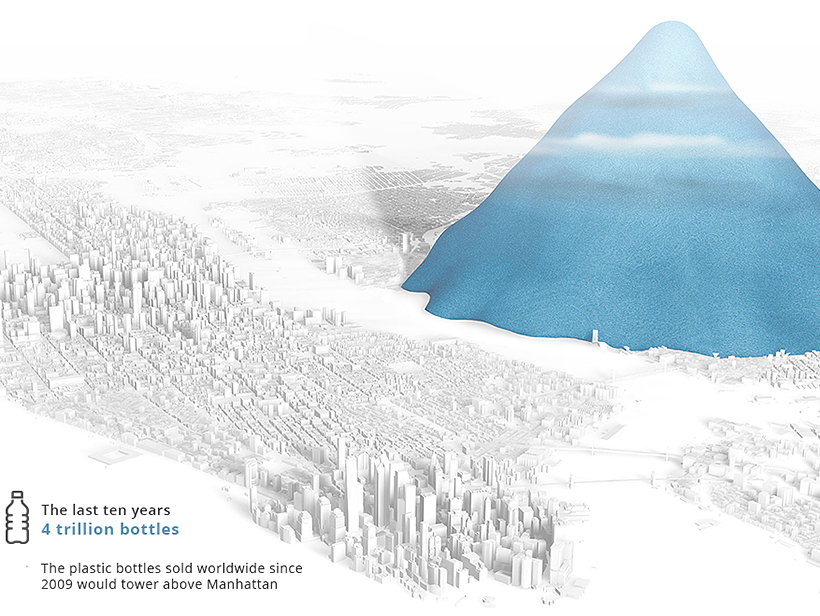
Original image from REUTERS/Simon Scarr, Marco Hernandez.
If all plastic bottle waste were piled up in this manner, New Yorkers would see a translucent mountain every time they looked out their window rising to over half the elevation of the tallest peak in the Rocky Mountains, which is 14,440ft (4.4km) high.
The Global Flow of Plastic Waste Since 1950
Plastic bottles are just the tip of the iceberg for single-use plastics. Other examples include plastic bags, food packaging, coffee cup lids, and straws. As plastic use continues to flourish, even our best attempts at managing waste are falling short.
In fact, only an abysmal 6% of all plastic produced since 1950 has been recycled, with the majority ending up in landfills as litter, or getting incinerated.
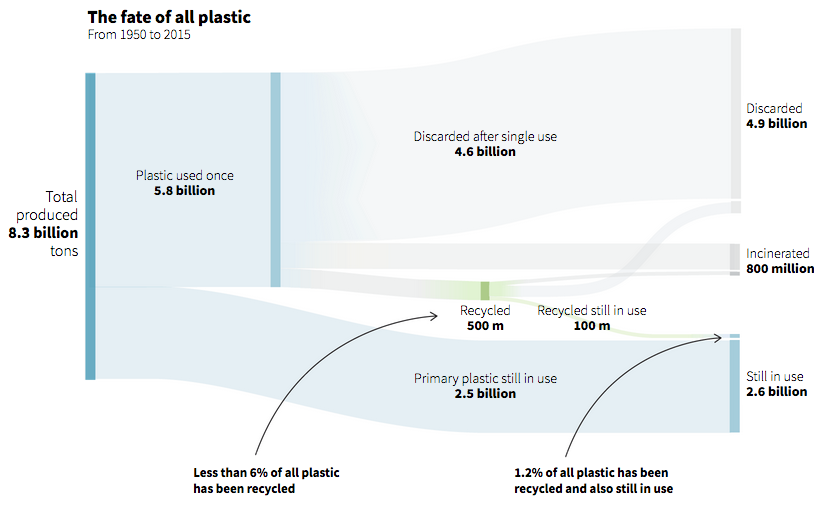
Original image from REUTERS/Simon Scarr, Marco Hernandez.
Our plastic use is on an unsustainable trajectory, but countries are taking specific actions to curb use. Canada and the European Union (EU) will ban certain single-use plastics by 2021—and they are among 60 other nations enacting similar policies.
Corporations are also taking steps to reduce impact. A good example of this is Unilever, which made a commitment to make all its packaging reusable, recyclable, or compostable by 2025.
Environment
The Most Polluted Cities in the U.S.
What are the most polluted cities in the U.S. according to data from the American Lung Association’s 2024 State of the Air Report?
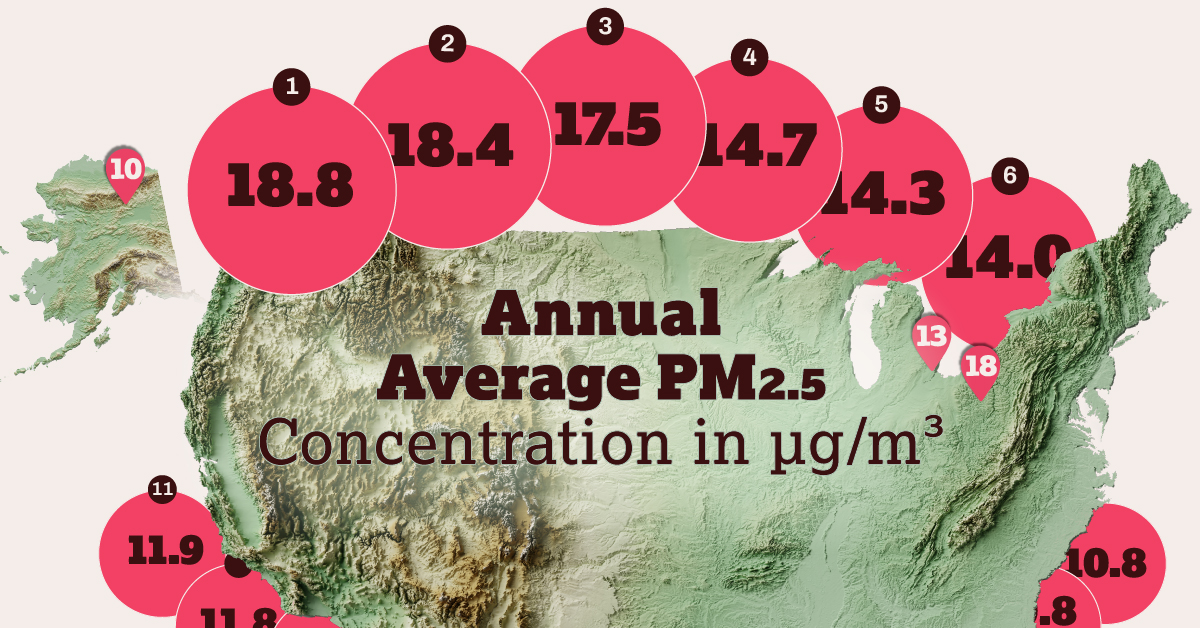
The Most Polluted U.S. Cities in 2024
According to the World Health Organization, air pollution is responsible for 7 million deaths annually, and could cost the global economy between $18–25 trillion by 2060 in annual welfare costs, or roughly 4–6% of world GDP.
And with predictions that 7 in 10 people will make their homes in urban centers by mid-century, cities are fast becoming one of the frontlines in the global effort to clear the air.
In this visualization, we use 2024 data from the State of the Air report from the American Lung Association to show the most polluted cities in the United States.
What is Air Pollution?
Air pollution is a complex mixture of gases, particles, and liquid droplets and can have a variety of sources, including wildfires and cookstoves in rural areas, and road dust and diesel exhaust in cities.
There are a few kinds of air pollution that are especially bad for human health, including ozone and carbon monoxide, but here we’re concerned with fine particulate matter that is smaller than 2.5 microns, or PM2.5 for short.
The reason for the focus is because at that small size, particulate matter can penetrate the bloodstream and cause all manner of havoc, including cardiovascular disease, lung cancer, and chronic pulmonary disease.
The American Lung Association has set an annual average guideline of 9 µg/m³ for PM2.5, however, the World Health Organization has set a much more stringent limit of 5 µg/m³.
The 21 Worst Polluted Cities in the U.S.
Here are the top 21 most polluted cities in the U.S., according to their annual average PM2.5 concentrations:
| Rank | City, State | Annual average concentration, 2020-2022 (µg/m3) |
|---|---|---|
| 1 | Bakersfield, CA | 18.8 |
| 2 | Visalia, CA | 18.4 |
| 3 | Fresno, CA | 17.5 |
| 4 | Eugene, OR | 14.7 |
| 5 | Bay Area, CA | 14.3 |
| 6 | Los Angeles, CA | 14.0 |
| 7 | Sacramento, CA | 13.8 |
| 8 | Medford, OR | 13.5 |
| 9 | Pheonix, AZ | 12.4 |
| 10 | Fairbanks, AK | 12.2 |
| 11 | Indianapolis, IN | 11.9 |
| 12 | Yakima, WA | 11.8 |
| 13 | Detroit, MI | 11.7 |
| T14 | Chico, CA | 11.6 |
| T14 | Spokane, WA | 11.6 |
| 15 | Houston, TX | 11.4 |
| 16 | El Centro, CA | 11.1 |
| 17 | Reno, NV | 11.0 |
| 18 | Pittsburgh, PA | 10.9 |
| T19 | Kansas City, KS | 10.8 |
| T19 | Las Vegas, NV | 10.8 |
Note: The American Lung Association uses Core Based Statistical Areas in its city and county rankings, which have been shortened here to the area’s principal city, or metro area in the case of the Bay Area, CA.
Six of the top seven cities are in California, and four in the state’s Central Valley, a 450-mile flat valley that runs parallel to the Pacific coast, and bordered by the Coast and Sierra Nevada mountain ranges. As a result, when pollution from the big population centers on the coast is carried inland by the wind—cities #5 and #6 on the list—it tends to get trapped in the valley.
Bakersfield (#1), Visalia (#2), and Fresno (#3) are located at the drier and hotter southern end of the valley, which is worse for air quality. The top three local sources of PM2.5 emissions in 2023 were farms (20%), forest management / agricultural waste burning (20%), and road dust (14%).
Benefit to Economy
While the health impacts are generally well understood, less well known are the economic impacts.
Low air quality negatively affects worker productivity, increases absenteeism, and adds both direct and indirect health care costs. But the flip side of that equation is that improving air quality has measurable impacts to the wider economy. The EPA published a study that calculated the economic benefits of each metric ton of particulate matter that didn’t end up in the atmosphere, broken down by sector.
| Sector | Benefits per metric ton |
|---|---|
| Residential Woodstoves | $429,220 |
| Refineries | $333,938 |
| Industrial Boilers | $174,229 |
| Oil and Natural Gas Transmission | $125,227 |
| Electricity Generating Units | $124,319 |
| Oil and Natural Gas | $88,838 |
At the same time, the EPA recently updated a cost-benefit analysis of the Clean Air Act, the main piece of federal legislation governing air quality, and found that between 1990 and 2020 it cost the economy roughly $65 billion, but also provided $2 trillion in benefits.
Benefit to Business
But that’s at the macroeconomic level, so what about for individual businesses?
For one, employees like to breathe clean air and will choose to work somewhere else, given a choice. A 2022 Deloitte case study revealed that nearly 70% of highly-skilled workers said air quality was a significant factor in choosing which city to live and work in.
At the same time, air quality can impact employer-sponsored health care premiums, by reducing the overall health of the risk pool. And since insurance premiums averaged $7,590 per year in 2022 for a single employee, and rose to $21,931 for a family, that can add up fast.
Consumers are also putting their purchase decisions through a green lens, while ESG, triple-bottom-line, and impact investing are putting the environment front and center for many investors.
And if the carrot isn’t enough for some businesses, there is the stick. The EPA recently gave vehicle engine manufacturer Cummins nearly two billion reasons to help improve air quality, in a settlement the agency is calling “the largest civil penalty in the history of the Clean Air Act and the second largest environmental penalty ever.”

Learn how the National Public Utilities Council is working toward the future of sustainable electricity.

-

 Environment1 month ago
Environment1 month agoRanked: Top Countries by Total Forest Loss Since 2001
The country with the most forest loss since 2001 lost as much forest cover as the next four countries combined.
-

 Environment3 months ago
Environment3 months agoCharted: Share of World Forests by Country
We visualize which countries have the biggest share of world forests by area—and while country size plays a factor, so too, does the environment.
-
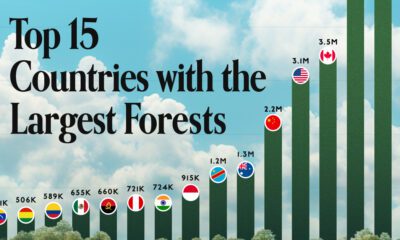
 Environment4 months ago
Environment4 months agoWhich Countries Have the Largest Forests?
Together, the top five countries with the largest forests account for more than half of the world’s entire forest cover.
-
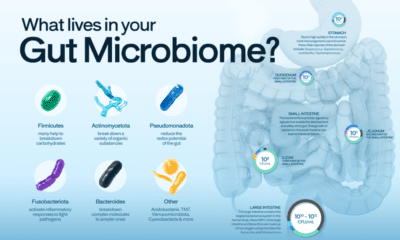
 Environment4 months ago
Environment4 months agoVisualized: What Lives in Your Gut Microbiome?
The human gut microbiome contains a world of microbes. We look at the the bacteria that deeply affect our health and well-being.
-

 Environment5 months ago
Environment5 months agoMapped: Global Temperature Rise by Country (2022-2100P)
In this set of three maps, we show the global temperature rise on a national level for 2022, 2050, and 2100 based on an analysis by…
-
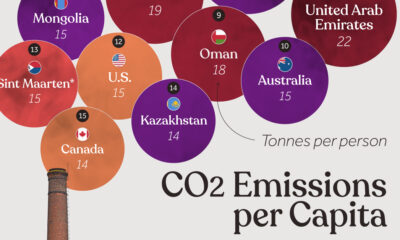
 Environment5 months ago
Environment5 months agoRanked: Per Capita Carbon Emissions by Country
Which countries rank the highest in per capita carbon emissions, and how do they impact the world’s total carbon emissions?
-

 Markets1 week ago
Markets1 week agoMapped: The Most Valuable Company in Each Southeast Asian Country
-

 Personal Finance7 days ago
Personal Finance7 days agoVisualizing the Tax Burden of Every U.S. State
-

 Mining7 days ago
Mining7 days agoWhere the World’s Aluminum is Smelted, by Country
-

 Technology1 week ago
Technology1 week agoCountries With the Highest Rates of Crypto Ownership
-

 Money1 week ago
Money1 week agoCharted: What Frustrates Americans About the Tax System
-

 Economy1 week ago
Economy1 week agoMapped: Europe’s GDP Per Capita, by Country
-

 Stocks1 week ago
Stocks1 week agoThe Growth of a $1,000 Equity Investment, by Stock Market
-

 Healthcare1 week ago
Healthcare1 week agoLife Expectancy by Region (1950-2050F)



